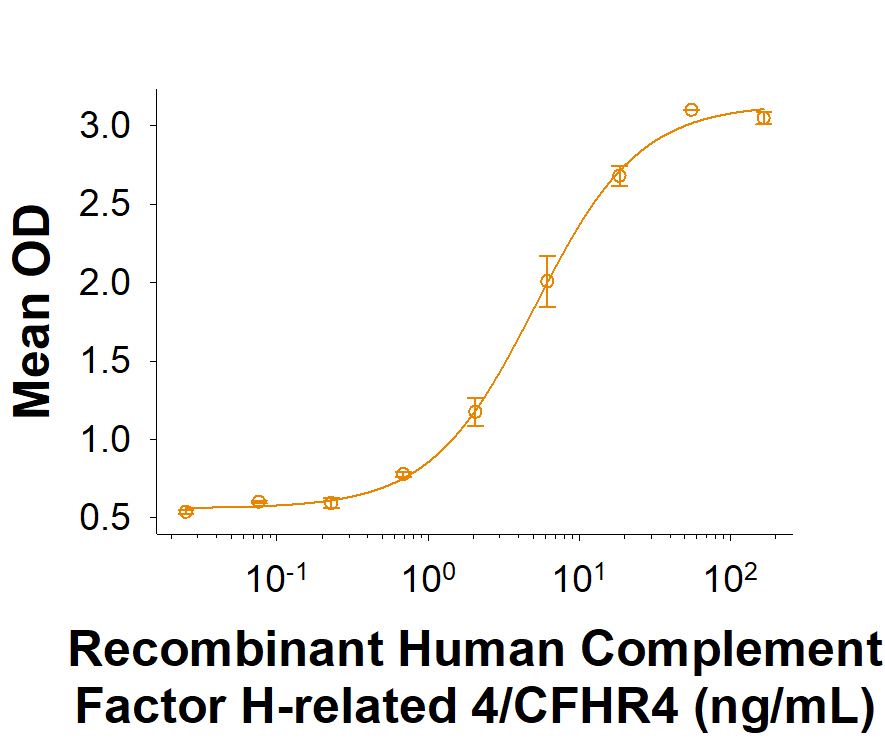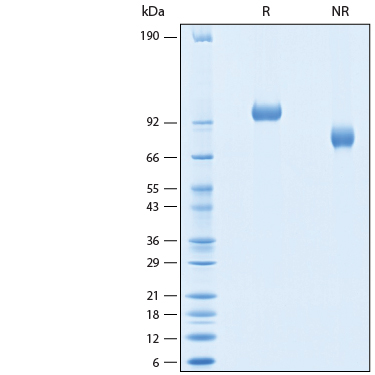Recombinant Human Complement Factor H-related 4/CFHR4, CF
Recombinant Human Complement Factor H-related 4/CFHR4, CF Summary
Product Specifications
Glu20-Glu578, with a C-terminal 6-His tag
Analysis
Product Datasheets
Carrier Free
CF stands for Carrier Free (CF). We typically add Bovine Serum Albumin (BSA) as a carrier protein to our recombinant proteins. Adding a carrier protein enhances protein stability, increases shelf-life, and allows the recombinant protein to be stored at a more dilute concentration. The carrier free version does not contain BSA.
In general, we advise purchasing the recombinant protein with BSA for use in cell or tissue culture, or as an ELISA standard. In contrast, the carrier free protein is recommended for applications, in which the presence of BSA could interfere.
11300-CH
| Formulation | Lyophilized from a 0.2 μm filtered solution in Tris and NaCl with Trehalose. |
| Reconstitution | Reconstitute at 200 μg/mL in PBS. |
| Shipping | The product is shipped at ambient temperature. Upon receipt, store it immediately at the temperature recommended below. |
| Stability & Storage: | Use a manual defrost freezer and avoid repeated freeze-thaw cycles.
|
Scientific Data
 View Larger
View Larger
When Recombinant Mouse Complement Component C3d His-tag (2655-C3) is immobilized at 2 µg/mL (100 µL/well), Recombinant Human Complement Factor H‑related 4/CFHR4 His-tag Protein (Catalog # 11300-CH) binds with an ED50 of 1.50-15.0 ng/mL.
 View Larger
View Larger
2 μg/lane of Recombinant Human Complement Factor H-related 4/CFHR4 His-tag Protein (Catalog # 11300-CH) was resolved with SDS-PAGE under reducing (R) and non-reducing (NR) conditions and visualized by Coomassie® Blue staining, showing bands at 92-103 kDa.
Reconstitution Calculator
Background: Complement Factor H-related 4/CFHR4
Complement factor H-related protein 4 (CFHR4) is a secreted glycoprotein member of the factor H family of glycoproteins (1). The human complement factor H protein family consists of the complement and immune regulators factor H, the factor H-like protein 1 (FHL-1) and five factor H-related proteins (FHR-1 to -5) (1). The genes of this family are located on human chromosome 1q32, which is known as the regulator of complement activation (RCA) gene clusters (2). CFHRs are exclusively composed of individually folded protein domains, termed short consensus repeats (SCRs) or complement control modules. All CFHRs, including CFHR4, are capable of binding complement factor C3b, discriminate between self and non-self cell surfaces, and have been proposed to deregulate complement activation by inhibiting interaction of CFH with C3b and C3d (1, 3). CFHR4 activates complement through its interaction with C3b (4). CFHR4 can also bind to native (pentameric) C-reactive protein (pCRP) through its first SCR domain and is suggested to promote pCRP binding to necrotic cells surfaces, thus promoting cell clearance (5). CFHR4 is synthesized as 2 isoforms by hepatocytes and circulates in plasma. The shorter isoform, FHR4B, contains 5 of 9 SCRs. The CFHR4 product includes a duplication insertion of 247 aa and represents the longer alternative splice form termed FHR4A (6).
- Skerka, C. et al. (2013) Mol. Immunol. 56:170.
- Diaz-Guillen, M.A. et al. (1999) Immunogenetics 49:549.
- Hellwage, J. et al. (1999) FEBS Lett. 462:345.
- Hebecker, M. and J. Jozsi (2011) J. Biol. Chem. 287:19528.
- Mihlan, M. et al. (2009) Mol. Immunol. 46:335.
- Jozsi, M. et al. (2005) Eur. J. Hum. Genet. 13:321.
FAQs
No product specific FAQs exist for this product, however you may
View all Proteins and Enzyme FAQsReviews for Recombinant Human Complement Factor H-related 4/CFHR4, CF
There are currently no reviews for this product. Be the first to review Recombinant Human Complement Factor H-related 4/CFHR4, CF and earn rewards!
Have you used Recombinant Human Complement Factor H-related 4/CFHR4, CF?
Submit a review and receive an Amazon gift card.
$25/€18/£15/$25CAN/¥75 Yuan/¥1250 Yen for a review with an image
$10/€7/£6/$10 CAD/¥70 Yuan/¥1110 Yen for a review without an image
